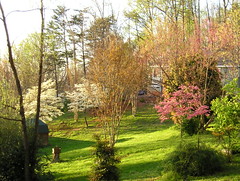Spring time here means rain. Lots and lots of rain. Our mountain retreat will seem more like Seattle for a month or so from late February through most of March. The ground will be soggy, the rivers run full, and we make good use of umbrellas and wide brimmed hats (like my fedora). Not only does it rain often, but some will be very heavy rainfalls, which can lead to the washing out of driveways and roads. Crusher-run gravel comes at a premium price at this time of year as residents scramble to repair damage to their drives and access roads. This year with all the budgets cut, including road maintenance, some of our normally top-notch roads are deteriorating rapidly. One that we normally use as a short-cut into town has become all but impassible because of the pot holes.
Spring Colors
 On the brighter side; we also enjoy the brilliant colors of spring; all the fruit trees burst into bloom practically overnight, the pink and white of Dogwood trees and the lavender of Redbud trees, yellow of Forsythia and bright red of Quince. The irises and day lilies have already put up their spiky green leaves and will soon flower into purple, orange and red blossoms. Pansies are already putting on a show, and a multitude of ground covers are popping open in purple, pink, yellow, and white flowers.
On the brighter side; we also enjoy the brilliant colors of spring; all the fruit trees burst into bloom practically overnight, the pink and white of Dogwood trees and the lavender of Redbud trees, yellow of Forsythia and bright red of Quince. The irises and day lilies have already put up their spiky green leaves and will soon flower into purple, orange and red blossoms. Pansies are already putting on a show, and a multitude of ground covers are popping open in purple, pink, yellow, and white flowers.
Spring Crops
It has been cold here this spring, some of the rain has been delivered as snow. Even the last few days of March brought a surprise day-long snow that was especially odd:
Installation Failure from Doug Bittinger on Vimeo.
This cold weather has delayed planting much of anything in my garden. Hopefully this cold snap we’re in now will be the last and I can start getting seed in the ground.
I did keep spinach, onions (for the greens), garlic and turnips growing all through the winter, but all of the lettuce and even the Brussels sprouts froze in a period of below zero temperatures.
Spring Lawn Prep
It’s also time to think about getting ready for the season of lawn care. Clean up the yard before mowing. Remove leaves, sticks, and other debris that has accumulated. Remove any dead spots visible in the lawn by vigorous raking. Once everything has been cleaned up and debris removed, I’ll follow with a lower than normal mowing. This should be short enough to remove the dead tips of the grass. This shorter mowing will encourage the roots to awaken and start growing. Naturally, I’ll compost the trimmings.
If I have any dead spots, I’ll re-seed those. I’ll start by raking the area thoroughly to roughen up the top soil. Spread an appropriate seed, tamp down the area and cover with straw. If reseeding is required, I’ll hold off using any fertilizers with pre-emergent weed controls. I’ll still have time to do this application in about 6 weeks. This will give the new grass seed time to sprout and take hold.
Must not forget to change the oil in the mowers and chipper and give them a thorough check-up to see that they are in good working order. I replaced the chipper knives last fall, I’ll sharpen or replace the mower blades this spring. A sharp blade cuts the grass, a dull one tears it. I’ll also send my chainsaw chains in for sharpening.
Thank you for reading, I hope you enjoyed it. Feel free to tell us about what’s going on in your part of the world in a comment below.

